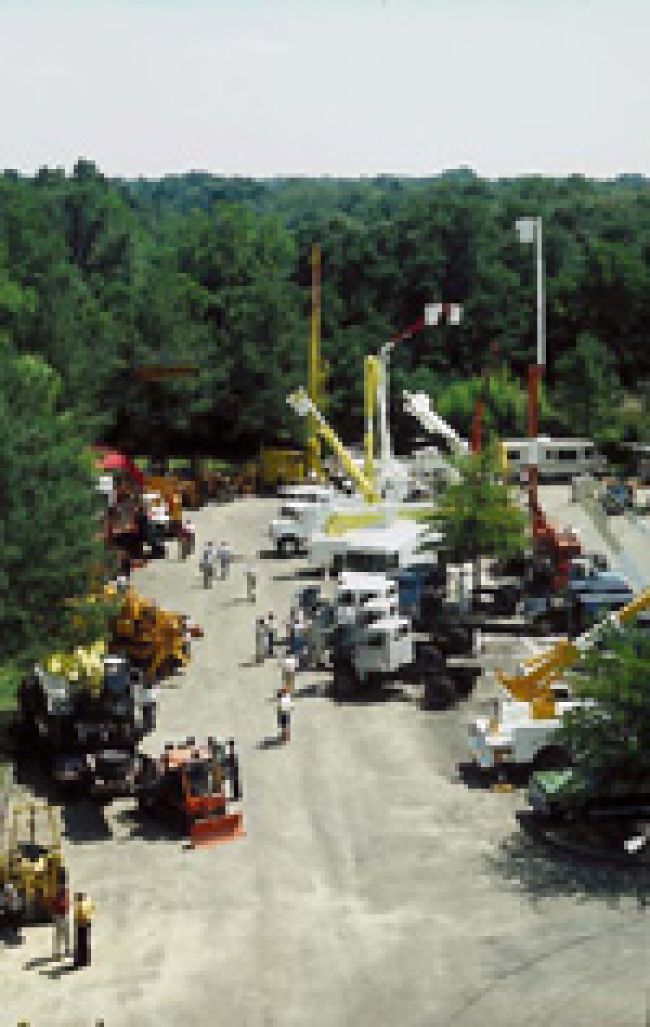
EUFMC 60th Anniversary
This year, the Electric Utility Fleet Managers Conference celebrates its 60th anniversary. Sixty years is bound to bring a significant amount of change to anything, and bucket trucks are no exception. Utility Fleet Professional talked with industry professionals for their thoughts on the evolution of aerial lift devices.
Bucket trucks 60 years ago were very useful for the times. “The first bucket trucks were tremendous improvements to work practices that eliminated climbing poles,” said Joe Caywood, director of marketing and strategic initiatives for Terex Utilities. Caywood said an innovative fiberglass boom also allowed lineworkers to work on and around live lines without being tied to the pole. “At the time, poles were shorter and chassis did not support large equipment, so the average distribution line truck was sized more like today’s trouble truck.”
In the last 60 years those first bucket trucks have seen transformation and progress in a variety of areas. “Equipment capabilities have leaped forward and the ability to improve work methods has provided a smarter, safer environment for the lineworker, with more productivity, less fatigue, and less long-term wear and tear on the worker,” said C. Michael Anderson, P.E., a North Carolina-based engineering consultant formerly with Altec Industries. “In the mid-1980s, the equipment changed significantly. Work methods allowed the lineman to take advantage of available advancements in hydraulics, composites, and vehicles such that ergonomics and safety are major features in addition to cost and productivity.”
“From a repair and maintenance standpoint, I think the engineering has come a long way [in the last 60 years],” said Judie Taylor, president of DUECO. “It’s not only about the engineering of the bucket trucks and the use of them, but also being able to maintain them better.”
Mechanical Advances
Progressive steps forward have been taken during the history of the bucket truck in regard to hydraulics, chassis and other important parts. “Power sources have historically relied on the chassis engine to provide power for the boom,” Caywood said. “Advancements with PTOs have significantly improved efficiency and reliability. Changes from carbureted gas engines to computer-controlled engines significantly improved engine control and reduced work site noise. Today advanced hybrid solutions provide a quiet alternative energy source supplied from onboard stored energy.”
“We are able to diagnose a lot more on the chassis side of things with troubleshooting and the computerization of that,” Taylor said. “On the tower side of it, the true bucket truck side of it, a lot of the hydraulics obviously have changed. Safety features have definitely been enhanced.”
Similar to chassis changes over the years, aerial devices have evolved significantly. “With pole heights increasing, the aerial devices increased in working height and platform capacity to match the requirements of the job. Over this time, features and options also continually advanced,” Caywood said. Some of these enhancements and developments include the single stick controller, material-handling jibs, hydraulically compensated (coordinated action) booms, telescopic booms, elevators, basket rotators and lifters, and advances with dielectric materials.
“Back when I started in 1994, I would say 48-foot units were significant and probably the most popular distribution units, whereas now 55-foot units are the most popular,” Taylor said. “There is an increase in the line heights, and pole heights have changed so utility trucks have had to change with that.”
Safety Regulations
Mechanics and power sources have gotten bigger and more complex, according to Darin Hinnergardt, Altec Sentry Safety Program manager, “which leads to increased training for a better educated, more informed workforce. As a result, there is a need for safer aerial devices and digger derricks,” he said.
Safety regulations have also helped the industry to progress, with the addition of OSHA’s 1926.1400 standard to address cranes and digger derricks in the field being the most recent. But Hinnergardt said that it wasn’t until 1971 that OSHA was established and brought guidance to the industry. “In the ’70s, the lower boom insert was introduced to help protect the ground worker,” he added.
Caywood said the biggest advantage has been the reduction of wear and tear on today’s lineworkers. “Linemen are working much longer, in better health, because of the reduction of stress on their body from not having to climb poles all day long. Features we take for granted such as boom interlocks and moving outrigger alarms aid the operator to perform their tasks safely.”
The Next 60
A look to the future will see continued focus on innovation, integration and weight management, according to Caywood. “Fuel savings will be realized by each pound that can be reduced from the aerial device through use of lighter-weight, higher-strength materials combined with efficient systems that integrate and control chassis, aerial and operator,” he said. “As with all improvements that have been yielded over the years, they start with the voice of the customer and recognizing their needs.”
Hybrid systems have been one of the biggest recent advancements, and Taylor expects that to continue in the future. “The introduction of hybrids certainly has, I think, helped the industry to be aware that there is definitely a need for alternative fuels,” Taylor said. “I do think hybrids are here to stay and we will see more evolution of that technology. I also think from a regulatory standpoint and a safety standpoint we will continue to see more stringent regulations on the industry with the operation of bucket trucks and digger derricks.”
About the Author: Wade Vonasek is a writer and editor. His work has appeared both in print and online for publications such as Mass Transit, Professional Tool & Equipment News, Fleet Maintenance and more. He resides in Bristol, Wis.

